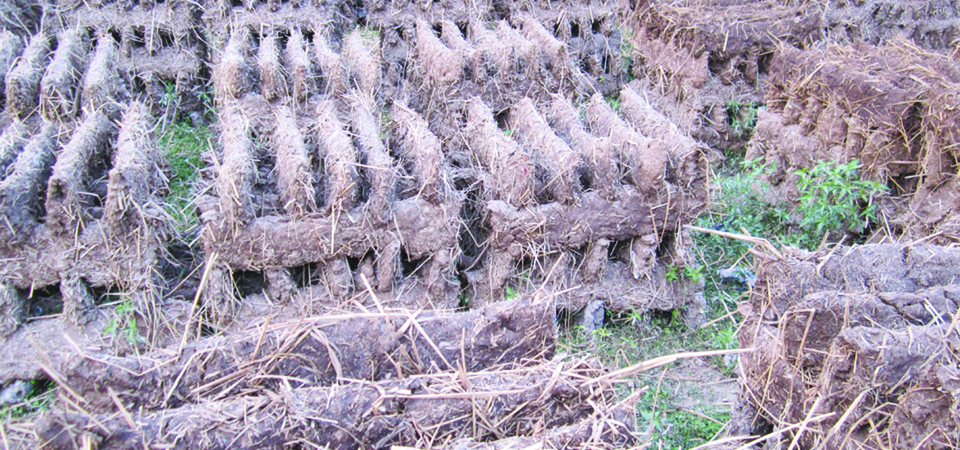Talented Mithila artists use cow dung as canvas

By Dhirendra Prasad Sah
Rajbiraj, Feb. 21: It’s a humbling notion – how some creature’s waste can be another’s treasure. For centuries we have known and utilised bovine excreta as a reliable source of fuel. But not many know that such piles of dung also work wonders while creating art. Normally used as alternative to firewood, Mithila artists mould Guinthas or cow dung cakes in creating fascinating works of art.
As the shape of Guinthas resembles modern weapons, the Mitihila artists mostly make faux weapons from cow dung, which are then used as props in dramas, dances and other facets of entertainment.
Likewise, the Maithili women show their adroitness in carving idols out of raw dung, and subsequently lining the little figurines in neat piles to dry in the warm sun.
“Dry cow dung has somewhat come into use to reflect Mithila art form. I have acted in a few plays using faux guns and guitars made of Guinthas,” said Jibachha Das, a local artist.
Traditionally, Guinthas have always played an important role in Mithila community. According to Shantidevi, they were used to light fire and keep the new-born infant and the mother warm. “Moreover, in our community, it is mandatory to light incense from Guintha during religious ceremonies. Some also apply the leftover ashes to their foreheads as holy stuff,” she added.
“The dung cakes are widely used as fuel. But only a few artists have been using the cow dung as canvas to reflect their skills,” said Sunita Kumari, another local.
A rather mundane part of every-day life in Terai, several observers are taken aback by artistic inspiration that helped transform excreta into craft. “Guinthas look attractive after various patterns are engraved into them. They look more beautiful when they are left to dry in the sun,” reflected Kumari, smitten by the line of freshly made Guintha figurines left to dry in the morning sun.
Guinthas are also known as Goraha in various Terai districts. “Flat dung cakes are made by adding jute, chaff and straw,” said Ranju Kumari, who belongs to the Mithila community. She added that Guinthas can be of various shapes and sizes. “In the local language, the longer dung cakes are called Goraha, shorter ones are called Guinthas and round ones are called Chepari,” she said.
Dev Narayan Yadav, a farmer, said that the dung cakes were especially used in traditional households to light fire. “Guinthas needed for the whole year are made at once and are stored in an attractive way,” he said.
Even though lighting fire from dung cakes requires more effort than the modern gas stoves, Guinthas of late are being popular as an alternative cheaper source of energy.
Around 70 to 80 per cent of households in the Mithila community have been using Guinthas for cooking.
Apart from a handful of Mihtila artists, other people are yet to wake up to the artistic value of Guinthas. Therefore, it is a shame to witness all those dung cakes getting burnt to ashes when they could be used for making art works to promote and reflect the richness of Mithila art and culture.
Recent News

Do not make expressions casting dout on election: EC
14 Apr, 2022
CM Bhatta says may New Year 2079 BS inspire positive thinking
14 Apr, 2022
Three new cases, 44 recoveries in 24 hours
14 Apr, 2022
689 climbers of 84 teams so far acquire permits for climbing various peaks this spring season
14 Apr, 2022
How the rising cost of living crisis is impacting Nepal
14 Apr, 2022
US military confirms an interstellar meteor collided with Earth
14 Apr, 2022
Valneva Covid vaccine approved for use in UK
14 Apr, 2022
Chair Prachanda highlights need of unity among Maoist, Communist forces
14 Apr, 2022
Ranbir Kapoor and Alia Bhatt: Bollywood toasts star couple on wedding
14 Apr, 2022
President Bhandari confers decorations (Photo Feature)
14 Apr, 2022










